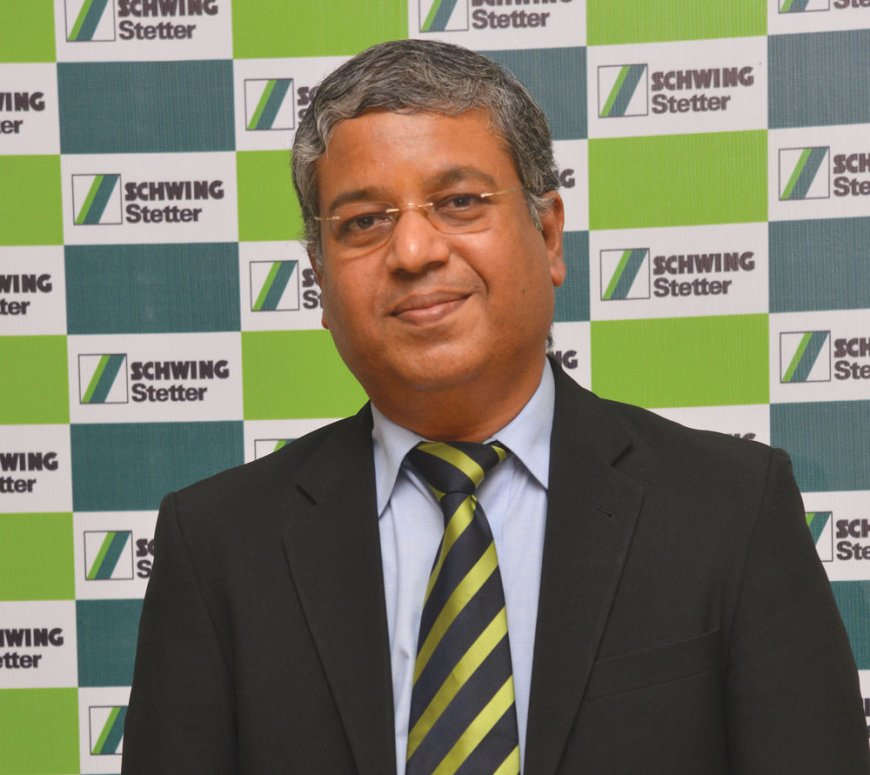Our company has experienced robust growth over the past three years, and we expect similar levels of growth in the coming years.
V.G. Sakthikumar, Managing Director, Schwing Stetter India How do you see the government’s ‘Make in India’ programme and mission motivating industry to participate in it? How is this helping the construction equipment sector to improve its technological status and competitiveness

How do you see the government’s ‘Make in India’ programme and mission motivating industry to participate in it? How is this helping the construction equipment sector to improve its technological status and competitiveness in the global market?
– The Make in India program is a positive initiative that is encouraging domestic manufacturing in India. The construction equipment sector is benefitting from this program due to the large size of the equipment and the high logistics costs associated with importing them. As a result, companies with strong manufacturing capacities are seeing growth opportunities in India. The program is improving the competitiveness of the construction equipment sector in the global market by promoting local manufacturing and reducing reliance on imports.
Foreseeing the government’s strong commitment and stable sentiments in the market, how do you evaluate your company’s growth in the coming years?
Our company has experienced robust growth over the past three years, and we expect similar levels of growth in the coming years. However, we remain cautious about the impact of parliamentary elections on the demand for machinery, like it happened in first half of 2019. In the long-term, we are optimistic about the growth potential of the Indian infrastructure and construction equipment market.
What are your views on making India as a global construction equipment manufacturing hub?
India has the potential to become a global manufacturing hub for construction equipment due to its skilled workforce and quality-driven manufacturing. However, high logistics costs and input material costs make it challenging to maintain consistency and reliability in the export market. Nonetheless, the Indian construction equipment sector has a competitive edge in terms of quality and cost, making it an attractive option for many countries.
Tell us on your export market and important initiatives to cater to the requirement of International market?
Our company has been exporting construction equipment to many countries, and we have seen a growing demand for Indian-made products due to their quality and cost competitiveness. In the current global climate, there is a clear preference for Indian products due to factors such as the war in Europe and high energy costs there.
Give us an understanding of your company’s performance in the last 3 years?
Our company has experienced growth organically and inorganically over the past three years. We have added more products through research and development and have also been trading imported machinery, for which there is a huge market but not enough volume to manufacture in India.
What is your future strategies at a time when technological disruptions are rapidly defining businesses in the sector?
Our future strategies involve launching new products and incorporating technological advancements to remain competitive in a rapidly changing business environment. We have already launched a series of concrete batching plants and concrete pumps for 3D printing and have worked with SCHWING equipment to develop recent tech demonstrators.
How is the scarcity of skilled operators affecting the prospects of the construction equipment market?
The scarcity of skilled operators is affecting the prospects of the construction equipment market. We believe that making certifications mandatory for operating equipment and investing in skilling programs will play a crucial role in addressing this issue. Our company is committed to training and skilling people and has created infrastructure, including simulators and classrooms, and signed MOUs to address this challenge.
CE manufacturers are now under pressure to manufacture machines which are not only cost effective, but also comply with the emission norms. What are your views on it?
Compliance with emission norms is an important issue for CE manufacturers. Every time we meet the emission norms, the cost of the product goes up due to the cost of the engine. However, customers may take time to adapt to the new version, which can lead to slump in sales. Nonetheless, we understand that compliance with emission norms is necessary and strive to meet these requirements.
What are the challenges that you face and what are your suggestions to further ease a business-friendly climate?
The challenges we face include managing fluctuating demands and maintaining a stable supply of equipment. We would ideally like to have a constant demand to avoid financial strain and the need for output optimisation or manpower alignment. To further ease the business-friendly climate, we believe that the government could focus on reducing logistics costs, improving infrastructure, and promoting skilling programs to address the shortage of skilled operators.
Hits: 27








